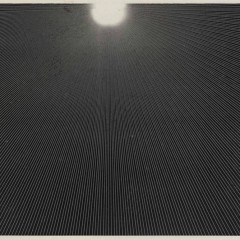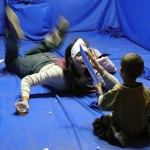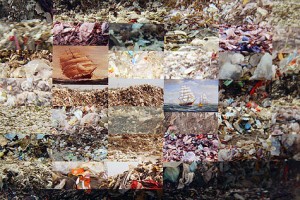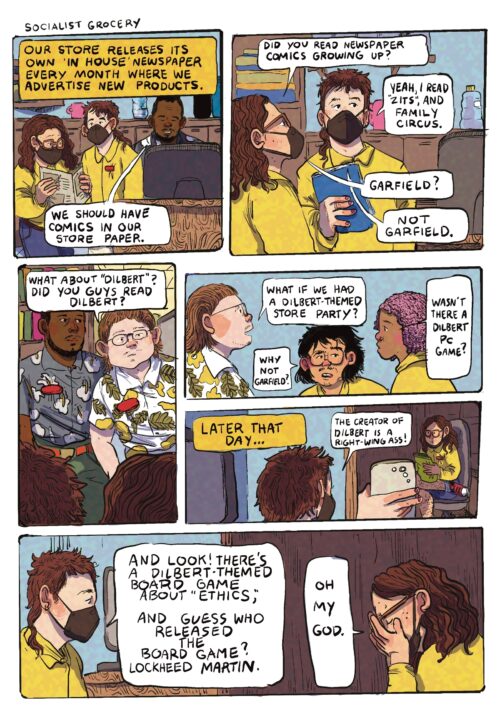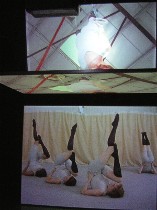 The work that engaged me most in New York this past visit was work that chewed on some aspect of politics.
The work that engaged me most in New York this past visit was work that chewed on some aspect of politics.
So I found myself interested in Jane and Louise Wilson‘s five-screen video installation “Erewhon” at 303Gallery until Nov. 6, even though it is somewhat repetitive. (“Erewhon” is the title of Samuel Butler’s satirical novel of a young Brit colonial who builds a new life in the isolation of New Zealand.)
The installation shows long, old-fashioned, oppressive institutional hallways; dormitory-like rooms with old bed springs; empty landscapes; and young women in a soaring modern space wearing First World War-era athletic gear and posing as if exercising.
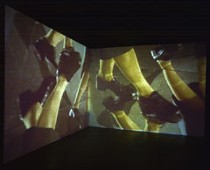 The idea of shooting creepy, abandoned spaces is classic Wilsoniana, although the angles and perspectives here are less original than the previous work, “Gamma,” that I’d seen from the twin sisters at the previous Carnegie International: “Gamma” (video still left) was filmed at Greenham Common, an American military base and cruise missile storage facility in England that was decommissioned in 1992.
The idea of shooting creepy, abandoned spaces is classic Wilsoniana, although the angles and perspectives here are less original than the previous work, “Gamma,” that I’d seen from the twin sisters at the previous Carnegie International: “Gamma” (video still left) was filmed at Greenham Common, an American military base and cruise missile storage facility in England that was decommissioned in 1992.
But what makes this newer video interesting is the young women holding exercise poses in a chorus-line (based on archival photos of ladies exercise classes from 1910).
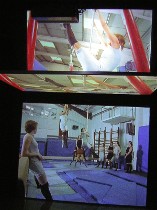 Turns out the source material for all this had to do with a eugenics ferver that swept through New Zealand (where the two British artists had been on a residency) after the death of so many of its young men in World War I. A fit young woman was deemed an appropriate vessel for the regeneration of the population. So exercise for women became a government program.
Turns out the source material for all this had to do with a eugenics ferver that swept through New Zealand (where the two British artists had been on a residency) after the death of so many of its young men in World War I. A fit young woman was deemed an appropriate vessel for the regeneration of the population. So exercise for women became a government program.
What interests me here, besides the held poses and the pleasing geometrics of chorus lines in Edwardian exercise gear, is the scary effectiveness of government in promoting its loopy, pre-Nazi concepts. The videos portray the women’s fitness platoons with a touch of cheesecake, which cements traditional ideas about women and their roles as sex-objects and then child-bearers.
People’s lives were disrupted, redirected, controlled by some government theory. The empty, dreary sanatoriums and hospitals brings to my mind author Pat Barker’s trilogy (“The Eye in the Door,” “Regeneration” and “The Ghost Road”) of the shell-shocked veterans from the war and horrors perpetrated by the era’s psychologists.
It also brings to mind our current delusion that if you exercise, you will be virtuous and healthy as well as fit. I see the armies of virtuous joggers in my neighborhood out ruining their knees as they slap their feet on the concrete. Anyway, I thought the work was worth a look. (Please don’t email me about how wonderful running makes you feel. You’d only be proving my point.)
Video from India
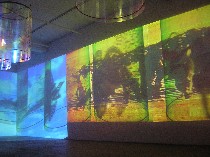 Work from Indian artist Nalini Malani, at Bose Pacia gallery until Oct. 23, has quite a different take on video. Her “Game Pieces” (left) include shadow images from Indian myth projected over richly colored video backdrops. The simplicity of using a sort of magic lantern to cast shadows of hand-painted figures over juicy, richly colored video was seductive, indeed. The figures appropriately enough are done in the lower-tech medium, the lanterns, but their message is about the modern world, hence the video.
Work from Indian artist Nalini Malani, at Bose Pacia gallery until Oct. 23, has quite a different take on video. Her “Game Pieces” (left) include shadow images from Indian myth projected over richly colored video backdrops. The simplicity of using a sort of magic lantern to cast shadows of hand-painted figures over juicy, richly colored video was seductive, indeed. The figures appropriately enough are done in the lower-tech medium, the lanterns, but their message is about the modern world, hence the video.
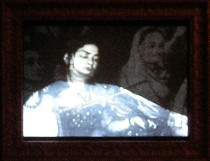 The repetition of the shadows as they circled around suggested the eternal truths of the myths and stories Malani evokes.
The repetition of the shadows as they circled around suggested the eternal truths of the myths and stories Malani evokes.
Another video installation, “Unity in Diversity” (image, video still, right), set in a red room with red velvet chairs, layers death and violence, based on the 2002 attacks against Muslims in Gujarat, India, with an 1893 painting that promoted pluralism in India. The piece is a plea for more rational times, and a sad commentary on how our thinking has gotten more primitive over time.
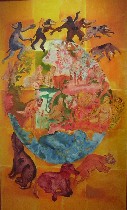
Malani also showed several paintings (left) that also blend old myths and storytelling with modern cultural values. Her paintings, like her video “Game Pieces,” offered rich colors and a blend of past and present.
Big whimsy and boy toys
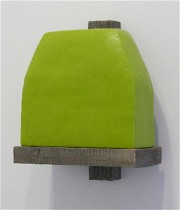 I want to mention some sculptures by Johannes Girardoni until Nov. 2 at Stephen Haller Gallery. The intensely colored what-is-its of beeswax, pigment and wood (image right, “Stacked.1-Nickel Green,” 18.5″ tall) remind me of giant version of David Goerk’s quirky, 3- or 4-inch sculptures that show at Larry Becker(see Roberta’s post). Girardoni’s pieces, because of their scale, suggest furniture, too. The intense jelly bean colors suggest a voluptuousness and joy in the material world; the rough wood is aescetic, the cross to bear.
I want to mention some sculptures by Johannes Girardoni until Nov. 2 at Stephen Haller Gallery. The intensely colored what-is-its of beeswax, pigment and wood (image right, “Stacked.1-Nickel Green,” 18.5″ tall) remind me of giant version of David Goerk’s quirky, 3- or 4-inch sculptures that show at Larry Becker(see Roberta’s post). Girardoni’s pieces, because of their scale, suggest furniture, too. The intense jelly bean colors suggest a voluptuousness and joy in the material world; the rough wood is aescetic, the cross to bear.
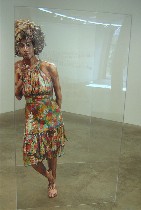 Also, Max Protetch is showing Oliver Herring until Nov. 6. Known previously for sculptures knit from Mylar, Herring’s new work is boyish in the extreme. There’s a video, “Trucks,” of dump trucks and backhoes leveling dirt on an arena floor. From the perspective of the camera they are toy size, and the almost fast-forward pacing makes it all seem rather dancy. Charming but thin.
Also, Max Protetch is showing Oliver Herring until Nov. 6. Known previously for sculptures knit from Mylar, Herring’s new work is boyish in the extreme. There’s a video, “Trucks,” of dump trucks and backhoes leveling dirt on an arena floor. From the perspective of the camera they are toy size, and the almost fast-forward pacing makes it all seem rather dancy. Charming but thin.
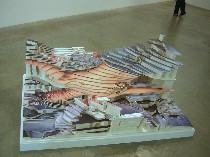 Figure sculptures realistically shaped and than collaged with bits from thousands of photographs of the model are amazingly realistic and life-sized (image, “Gloria” above left, 72″). Ten for the successful trick, four for the content.
Figure sculptures realistically shaped and than collaged with bits from thousands of photographs of the model are amazingly realistic and life-sized (image, “Gloria” above left, 72″). Ten for the successful trick, four for the content.
Herring also created a kind of topographic map of a photo of a drapey guy that turned him into an amphitheater (not quite successful, but interesting). Both of these works raise questions about the difference between 2-D and 3-D, machine (camera) generation of imagery and human generation (image right, “Birdseye View of the Theatre Below”).
In addition, Herring has a newspaper-like folio of photos of no news at all. It’s documentation of two (adult) brothers playing in mud. This and two series of unframed photos telling a story of two people in his home reminded me of “Trucks,” with its boys-at-play affect. Not so interesting.
 And while we’re on photos, Sonnabend has another of the Becher’s progeny–Candida Hofer–taking big, empty public spaces like libraries and palaces full of swell detail–antecedents to Thomas Struth, but not quite as loaded. Nonetheless, there’s still plenty to look at. It’s open until Oct. 30 (image left, “Osterreichische Nationalbibliothek Wien VIII”).
And while we’re on photos, Sonnabend has another of the Becher’s progeny–Candida Hofer–taking big, empty public spaces like libraries and palaces full of swell detail–antecedents to Thomas Struth, but not quite as loaded. Nonetheless, there’s still plenty to look at. It’s open until Oct. 30 (image left, “Osterreichische Nationalbibliothek Wien VIII”).
Stitchery
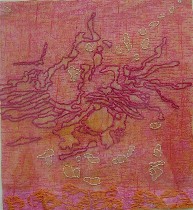 I’ve seen a lot of stitchery lately–Laura Owens at the Fabric Workshop, , Xiang Yang at Spector Gallery–so I tuned in at Christine Blair‘s stitched prints at George Billis. In contrast to Owens’ oversized pieces, Blair’s stitched monoprints were the right scale, 9 5/8″ x 9″. The work was rich with detail, color and texture, and it pulled me right in. Also at Billis, Daniel Schottenfeld’s gouache iconic consumer goods were charming, even if a little expected. And Nicholas Evans-Cato’s pleasant landscapes made me feel like I’d never left Philadelphia. Up until Oct. 30 (image right, Blair’s “Configuration No. 3,” 2004, print monotype on fabric with hand embroidery).
I’ve seen a lot of stitchery lately–Laura Owens at the Fabric Workshop, , Xiang Yang at Spector Gallery–so I tuned in at Christine Blair‘s stitched prints at George Billis. In contrast to Owens’ oversized pieces, Blair’s stitched monoprints were the right scale, 9 5/8″ x 9″. The work was rich with detail, color and texture, and it pulled me right in. Also at Billis, Daniel Schottenfeld’s gouache iconic consumer goods were charming, even if a little expected. And Nicholas Evans-Cato’s pleasant landscapes made me feel like I’d never left Philadelphia. Up until Oct. 30 (image right, Blair’s “Configuration No. 3,” 2004, print monotype on fabric with hand embroidery).
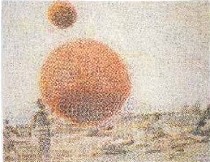 Already gone from the Cue Art Foundation were two wonderful bodies of work, one by cartoonist Jerry Moriarty and one by artist Stephan Andrews.
Already gone from the Cue Art Foundation were two wonderful bodies of work, one by cartoonist Jerry Moriarty and one by artist Stephan Andrews.
Andrews’ works, curated by filmmaker Atom Egoyan, were crayon rubbings on parchment of deadly incidents in the Iraq war, based on photos and video clips. The rubbings came across as pixillated, the colors separated, the imagery dissolving into the medium. The work is beautiful at the same time that the incidents depicted are horrifying (image left, “Friendly Fire (a BBC cameraman also received minor injuries but continued to film with his blood dripping on the lens),” 14″ x 16″).
Unlike Seurat, Andrews’ goal is not to make the colors come together but rather to fall apart. There’s a conversation going on here between photographs and the drawings, between direct video and recreated video, between the impersonal images of war and Andrews’ personal images. The shift from camera and reportage to hand work and time expended only adds to the sadness, the feeling of lives disappearing.
The show included a video and a wall of serial images for the video, based on a real video clip from the war. The action of the video gets caught and dissolves at the same time. This was great work, and a reminder of what’s being lost on both sides on a daily basis in that faraway place.
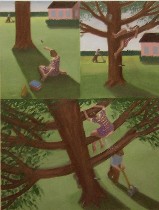 Jerry Moriarty’s large oil and acrylic paintings use comic book serial frames to tell brief, mordant stories, some of them clearly about his life. This one is “Sally’s Surprise–Tree Pee” (60″ x 46″), but others include the artist (loved his gray pony tail) in incidents (real or dreamed?) with his father (who looks younger).
Jerry Moriarty’s large oil and acrylic paintings use comic book serial frames to tell brief, mordant stories, some of them clearly about his life. This one is “Sally’s Surprise–Tree Pee” (60″ x 46″), but others include the artist (loved his gray pony tail) in incidents (real or dreamed?) with his father (who looks younger).
 After a day of pounding the pavement, I went with Judy Gelles to a book publication party for her friend, Martha Cooper, who just published “Hip Hop Files,” a photographic history of hip hop’s early years. The crowd included a DJ behind multiple turntables and lots of hip-hoppy looking men and women, many not so young, chronicled in the photographs. Here’s Martha autographing a book for one of her subjects.
After a day of pounding the pavement, I went with Judy Gelles to a book publication party for her friend, Martha Cooper, who just published “Hip Hop Files,” a photographic history of hip hop’s early years. The crowd included a DJ behind multiple turntables and lots of hip-hoppy looking men and women, many not so young, chronicled in the photographs. Here’s Martha autographing a book for one of her subjects.
We drove home to the drone of the final debate on the radio. We had to imagine Bush’s jaw clenching.


